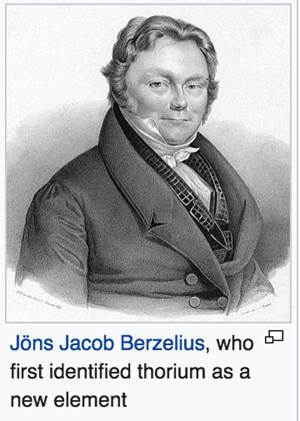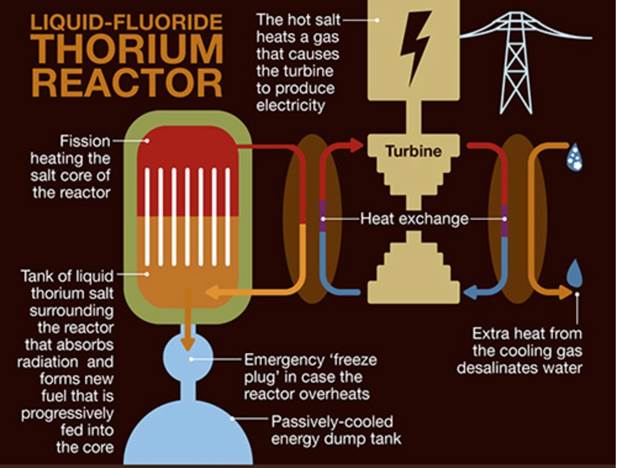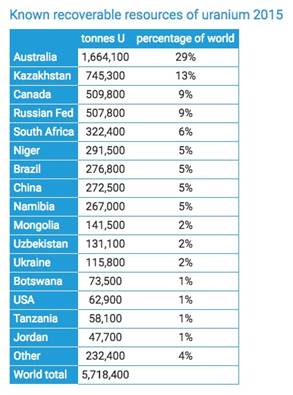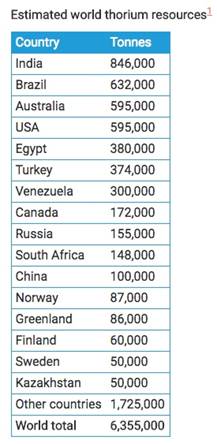Thorium, Uranium's Ugly Stepsister for Nuclear Reactor Fuel / Commodities / Nuclear Power
 Mostjunior resource investors know uranium, and many got in on the action whenNexGen Energy and Fission Uranium made their discoveries in the Athabasca Basinof Saskatchewan, the region with the highest grades of uranium in the world.Smart, or lucky, shareholders of NXE enjoyed a cumulative share price rise ofaround 430% between 2014 and 2016, while Fission Energy - famous for itsPatterson Lake South property that yielded the open-pittable Triple R deposit -jumped from 91 cents in November 2013 to $1.62 a share in April 2014, for again of 78%.
Mostjunior resource investors know uranium, and many got in on the action whenNexGen Energy and Fission Uranium made their discoveries in the Athabasca Basinof Saskatchewan, the region with the highest grades of uranium in the world.Smart, or lucky, shareholders of NXE enjoyed a cumulative share price rise ofaround 430% between 2014 and 2016, while Fission Energy - famous for itsPatterson Lake South property that yielded the open-pittable Triple R deposit -jumped from 91 cents in November 2013 to $1.62 a share in April 2014, for again of 78%.
Uraniumis the fuel needed to create the nuclear reaction that can either createnuclear power or nuclear weapons. To make nuclear fuel from uranium ore, theuranium is first extracted from the rock, then enriched with the uranium-235isotope, before being made into pellets that are loaded into assemblies ofnuclear fuel rods. In a nuclear reactor, several hundred fuel assembliescontaining thousands of small pellets of uranium oxide are in the reactor core.The nuclear chain reaction that creates energy starts when U-235 splits or“fissions”, which produces a lot of heat in a controlled environment.
Ina conventional nuclear reactor, the pressurized water reactor, fuel rodscontaining uranium pellets are placed in water. Visualized as a giant kettle,the heat generated from the pellets boils water to create steam, which turnsturbines to generate electricity. But the downside of conventional nuclearpower stations is the nuclear reaction also produces plutonium, which is highlyradioactive, and other wastes, causing a problem for disposal. Stronium-90 andcesium-137, contained in nuclear waste, have half-lives of about 30 years, butplutonium-239 takes 24,000 years to fully decay.
Whenit works well, the nuclear reaction is an efficient form of energy creation. Oneuranium pellet weighing just 6 grams is said to produce the same amount ofenergy as a tonne of coal. But it also leaves a lot of radioactive waste thatneeds to be incinerated, encased in concrete, or buried deep underground forcenturies.
Whennuclear power goes wrong, the fallout is catastrophic. Nuclear meltdowns likeChernobyl in Russia, Three Mile Island in the US, and Fukushima in Japan areburned into the collective consciousness and serve as constant reminders of thedangers of nuclear power that drive the anti-nuke movement.
Whilenuclear energy generation will never be without risks, proponents argue theseare manageable and small compared to the risk of increased greenhouse gasemissions caused by the continued burning of fossil fuels for power, that arewarming the planet. For this reason, nuclear is always in the mix of energiesrequired to make the transformation from an oil-based economy to one whererenewable and nuclear energies make up a larger proportion of our globalelectricity. The question is, must we keep using uranium in our nuclear powerplants, or is there another option? There is. It’s uranium’s ugly stepsister, alittle-known element known as thorium.
Somescientists believe thorium is key to developing a new version of cleaner, safernuclear power. So why hasn’t thorium entered the popular and investor lexiconlike uranium has? The silvery-white metal has a fascinating history, anddespite taking a backseat to uranium as the primary nuclear fuel, it is makinga comeback. This is the story of thorium, the wünder-fuel that wasn’t, butcould be.
History
Thoriumis named after Thor, the Norse god of thunder. It was first discovered in 1815by Jöns Jakob Berzelius, a Swedish chemist, but a few years later it wasdetermined that the mineral was actually yttrium phosphate. In 1828 Berzeliuswas given a sample of a black mineral found on an island off the coast ofNorway by Hans Esmark, a Norwegian mineralogist. The mineral contained severalknown elements including lead, tin, iron, manganese and uranium, but 60% was anunknown substance that was subsequently named thorite. Thorium was firstisolated by mixing thorium oxide with carbon, creating thorium chloride. Whenreacted with potassium, the result was thorium and potassium chloride, accordingto Chemicool. It took another 70 years for scientists to realize that thoriumwas radioactive. The discovery was made by Gerhard Schmidt, a German chemist,and Marie Cure, a Polish physicist, who are often credited with its discovery.

Thoriumoxide (ThO2) has the highest melting point of all oxides (3300°C) so it’s notsurprising that its early applications were in lantern mantles, arc-lightlamps, welding electrodes and heat-resistant ceramics. Thorium oxide is alsoused in camera lenses and scientific instruments.
Abundance
Thoriumis actually fairly common on Earth. According to Livescience it occurs in theEarth’s crust at 6 parts per million - about as much as lead and three timesmore abundant than uranium; it is the 41st most abundant element on Earth.
Howeverit is thought to be rare because thorium is normally found as minor constituentsof metals. Interestingly though, natural thorium occurs as almost pure 232Th,the most stable thorium isotope, which has a half-lifecomparable to the age of the universe (14 billion years), andwhose radioactive decay is the largest contributor to the Earth’s internalheat. Right now it’s estimated the planet still has about 85% of the thoriumpresent when the Earth was formed. Scientists at Los Alamos National Laboratory- where the first nuclear weapons were designed as part of the ManhattanProject - think that thorium was created in the cores of supernovae (the laststages of a star’s life), then scattered across the universe when the starsexploded.
Traceelements are found in rocks, soil, water, plants and animals, with higherconcentrations contained within thorite, thorianite, monazite, allanite, andzircon. The element is mined mostly in Australia, Brazil and India. The rareearth mineral monazite contains between 6 and 12% thorium phosphate.
Accordingto the World Nuclear Association (WNO) worldmonazite resources are estimated at around 16 million tonnes, 12MT of which arefound in mineral sands deposits in India. A large vein deposit of thorium andrare earth elements is in Idaho. Recovering thorium from monazite involvesleaching it with sodium hydroxide at 140°C followed by a process to precipitatepure ThO2. The WNO states that under 10,000 tonnes a year of monazite areextracted per year from India, Brazil, Vietnam and Malaysia, and “without commercial rare earth recovery, thorium production is noteconomic at present.”
Use in nuclear energy
Thestory gets really interesting when thorium was found to be radioactive - justtwo years after the discovery of uranium radioactivity by French physicistHenry Bequerel. Initially thorium’s radioactivity was thought to have healthbenefits, and was promoted as a cure for rheumatism, diabetes and evenimpotence. However in 1932 these uses were banned due to a federalinvestigation that found that people injected with thorium suffered fromleukemia and abnormal chromosomes.
Attentionthen turned to the use of thorium in nuclear energy. During the Cold War the USlooked at using 232Th to create 233U - which was being investigated as both areactor fuel and to build nuclear bombs. But the US Military rejected a bombbuilt with 233U because it did not have “technical advantages” over uranium-plutoniumbombs and especially since it it is difficult to produce pure 233U states a 1966technical report.
Uranium’schief advantage over thorium, as a nuclear fuel, was that it could be used toproduce both atomic weapons and nuclear power, while thorium, unlike uranium,is not “fissile” – meaning it cannot be split to make a nuclear chain reaction– and could only be applied to nuclear power.
Withthe United States in the early stages of an arms race against the former SovietUnion to develop a nuclear arsenal, it was easy to see which element would winout. While thorium was used in a later version of America’s first civiliannuclear power plant - headed up by Hyman Rickover, the US admiral responsiblefor creating the world’s first nuclear-powered submarine - it would take a backseat to uranium as the primary fuel for nuclear reactors.
Thoriumnuclear reactors were developed at the Oak Ridge National Laboratory to supportnuclear-powered long-range bombers, but the program was scrapped in 1961 infavor of other technologies according to a 2009 NASA paper. This isbecause the liquid fluoride thorium reactors did not produce as much plutonium,needed for developing nuclear weapons, as uranium-powered reactors.
Nonetheless,the first thorium-based nuclear reactor was built at the Indian Point EnergyCenter, New York, in 1962.
Asmentioned thorium is not able to split an atom to produce the nuclear reaction;instead, when thorium is exposed to neutrons, it eventually emerges into theisotope U-233, which splits and releases energy. In this way thoriumis said to be “fertile” rather than fissile. Recycled plutonium canalso be used with thorium.
Uranium vs thorium
Otherthan the fact that uranium is better than thorium in building nuclear weapons,how do the two nuclear fuels stack up against one another? According to the Royal Society of Chemistry, thorium’sbenefits include:
Thorium is three to four times more abundant than uranium. Thereis estimated to be enough thorium on the planet to last 10,000 years. Thorium is more easily extracted than uranium.Liquid fluoride thorium reactors (LFTR) - a type of molten saltreactor - have very little waste compared with reactors powered by uranium. It is more efficient. One tonne of thorium delivers the sameamount of energy as 250 tonnes of uranium.LFTRs run at atmospheric pressure instead of 150 to 160 timesatmospheric pressure currently needed for water cooled reactors. Thorium is less radioactive than uranium.The2011 Fukushima disaster in Japan soured the world on nuclear, and startedscientists looking more closely at thorium as a “greener” alternative. Whileconventional nuclear plants are only able to extract 3-5% of the energy inuranium fuel rods, in molten salt reactors favored by thorium proponents,nearly all the fuel is consumed. Where radioactive waste from uranium-basedreactors lasts up to 10,000 years, residues from the thorium reaction willbecome inert within 500. Lastly, because plutonium is not created as a wasteproduct in a thorium reactor, it cannot be separated from the waste and used tomake nuclear weapons. Although, the World Nuclear Association points out that theUnited States made about two tonnes of U-233 during the Cold War and detonateda nuclear weapon containing U-233. The explosive yield though was less thanexpected, just 22 kilotons. In 1998 India detonated a small nuclear device fromU-233.
Asfar as disadvantages, thorium takes extremely high temperatures to producenuclear fuel (550 degrees higher than uranium dioxide), meaning thorium dioxideis expensive to make. Second, irradiated thorium is dangerously radioactive inthe short-term. Detractors also say the thorium fuel cycle is less advancedthan uranium-plutonium and could take decades to perfect; by that time,renewable energies could make the cost of thorium reactors cost-prohibitive.The International Nuclear Agency predicts that the thorium cycle won’t becommercially viable while uranium is still readily available.
Molten salt nuclear reactors
Moltensalt reactors (MSRs) are well suited to thorium fuel, and while they were firstconceived of in the 1940s, as noted above, to fuel aircraft, there has been arenewed interest in them. In the Liquid Fluoride Thorium Reactor (LFTR), thefuel is not cast into pellets like uranium, but is rather dissolved in a vat ofliquid salt.
According to ZME Science, sincemolten salt reactor technology was revived in the 2000s, interest has grownquickly, with four companies in the US announcing plans for MSRs, as well as inJapan, Russia, France and China. In Norway, Thor Energy started producing powerfrom thorium at its Halden test reactor in 2013, with help from Westinghouse.The third phase of a five-year thorium trial operation got underwayin January.

India’sthorium program is well advanced. The country envisions meeting 30% of itselectricity demands through thorium-based reactors by 2050. With largequantities of thorium and little uranium, India wants to use thorium forlarge-scale energy production. It plans to construct and commission a fleet of500 sodium-cooled fast reactors - which burn spent uranium and plutonium - inorder to breed plutonium to be used in its advanced heavy water reactors thatemploy thorium as the nuclear fuel. A prototype of the 500-megawatt fastbreeder reactor (FBR) in Kalpakkam, India was supposed to be finished in late2017 but has been put off to later this year.
Oneof the main advantages of MSRs is the reactor cannot melt down, as we saw inFukushima when electric pumps were inundated by the tsunami, failing to coolthe fuel rods, which overheated and caused radiation emissions. MSRs can alsobe made cheaper and smaller than conventional reactors, since they do not havelarge pressurized containment tanks, meaning they could be used in factorysettings. MSRs use molten salt instead of water as a coolant, allowing them toreach temperatures over 80°C, three times hotter than a conventional nuclearplant cooled with water.
Anotheradvantage is that nuclear waste (ie. plutonium) can be recycled to recover thefissile materials needed to create the nuclear reaction. In this way, thoriumreactors not only generate less waste than conventional reactors, but also helpto rectify the nuclear waste disposal problem.
Work continues
Examplesof companies and countries that are testing thorium’s viability as a nuclearfuel keep growing. Last summer a Dutch nuclear institute started experimentingwith MSRs. NRG, the name of the facility, on the North Sea coast of theNetherlands, launched the Salt Irradiation Experiment in collaboration with theEU. New Scientist reports the researchers willuse thorium as the nuclear fuel for the reactor where both the reactor fuel andthe coolant are a mixture of molten salt. The experiment will also examine howto deal with the nuclear waste.
Indonesia,which has a large amount of thorium contained within monazite, signed an agreement three years ago with US companyThorCon Power, to develop molten salt reactors. A 1,000-megawatt thorium-basedreactor would be used for base-load power and produce 5 gigawatts a year. Thecountry wants around 20% of its energy mix to come from thorium molten saltreactors by 2050.
Inthe United States, the Department of Energy is partnering with TerraPower,Vanderbilt and the Oak Ridge National Lab, among others, to build a moltenchloride fast reactor - a type of MSR - Oilprice.com reported. Southern Company in2016 was the second firm to receive a grant from the DOE.
China,seemingly always on the leading edge of new energy, has put aside US$3.3billion to build two molten salt reactors in the Gobi Desert, to be up andrunning by 2020, the South China Morning Post said in December. Thereactors could spawn new uses for the radioactive element, includingapplications in warships and drones.
Conclusion
If there hadn’t been an urgent need to develop nuclearweapons for the Cold War, there’s a reasonably good chance that thorium ratherthan uranium would have become the nuclear fuel of choice. The ability ofuranium to kickstart the nuclear reaction makes it one of the moststrategically important minerals on Earth. If the world was running out ofuranium, thorium demand, and the technology to make molten salt reactors, wouldprobably be much farther advanced than it currently is. But we are not runningout of uranium. According to the World Nuclear Association (WNA), in2017, world uranium production totalled 59,531 tonnes, which satisfied 92% ofworld demand. The top producers are Kazakhstan, Canada and Australia. Totalknown, recoverable uranium resources as of 2015 were 5.718 million tonnes.


Contrast this with thorium. The WNA states there are 6.555 milliontonnes of thorium resources in the world - with most thorium held in India,Brazil and Australia/ the US (tied for third). That’s a bit more than totaluranium resources. But how much thorium is mined? According to the USGS, in2017, only 2.2 tons of thorium (mostly monazite) were imported into the UnitedStates; thorium compound exports were 83 tons. Obviously the tiny numbers arebecause there is currently no market for thorium. But if there was, there arearound 6 million tonnes of resources waiting to be converted into reserves.Quite an opportunity for thorium explorers should molten salt reactors evercatch on enough to augment, let alone replace, conventional uranium-basedreactors. The demand for thorium fuel, and its price, would skyrocket.
For now, thorium is a theoretical solution to our energy dilemma,but it could be much more than that. A concerted effort to develop thoriumreactor technology could provide stable, clean, base-load power for millions,something that is not possible with renewables due to the intermittency factor(ie. power can only be generated when the sun shines and the wind blows) andthe current early stages of renewable battery storage technology. It is saferand better for the environment than uranium, and can even use radioactive wasteas feedstock for the nuclear reaction, thus killing two birds with one stone.The market isn’t yet ready for thorium, but when it is, a whole new mining sectorand supply chain will be born.
Thorium and its potential for resource exploration is on my radarscreen.
By Richard (Rick) Mills
If you're interested in learning more about the junior resource and bio-med sectors please come and visit us at www.aheadoftheherd.com
Site membership is free. No credit card or personal information is asked for.
Richard is host of Aheadoftheherd.com and invests in the junior resource sector.
His articles have been published on over 400 websites, including: Wall Street Journal, Market Oracle,USAToday, National Post, Stockhouse, Lewrockwell, Pinnacledigest, Uranium Miner, Beforeitsnews, SeekingAlpha, MontrealGazette, Casey Research, 24hgold, Vancouver Sun, CBSnews, SilverBearCafe, Infomine, Huffington Post, Mineweb, 321Gold, Kitco, Gold-Eagle, The Gold/Energy Reports, Calgary Herald, Resource Investor, Mining.com, Forbes, FNArena, Uraniumseek, Financial Sense, Goldseek, Dallasnews, Vantagewire, Resourceclips and the Association of Mining Analysts.
Copyright © 2018 Richard (Rick) Mills - All Rights Reserved
Legal Notice / Disclaimer: This document is not and should not be construed as an offer to sell or the solicitation of an offer to purchase or subscribe for any investment. Richard Mills has based this document on information obtained from sources he believes to be reliable but which has not been independently verified; Richard Mills makes no guarantee, representation or warranty and accepts no responsibility or liability as to its accuracy or completeness. Expressions of opinion are those of Richard Mills only and are subject to change without notice. Richard Mills assumes no warranty, liability or guarantee for the current relevance, correctness or completeness of any information provided within this Report and will not be held liable for the consequence of reliance upon any opinion or statement contained herein or any omission. Furthermore, I, Richard Mills, assume no liability for any direct or indirect loss or damage or, in particular, for lost profit, which you may incur as a result of the use and existence of the information provided within this Report.
© 2005-2018 http://www.MarketOracle.co.uk - The Market Oracle is a FREE Daily Financial Markets Analysis & Forecasting online publication.
